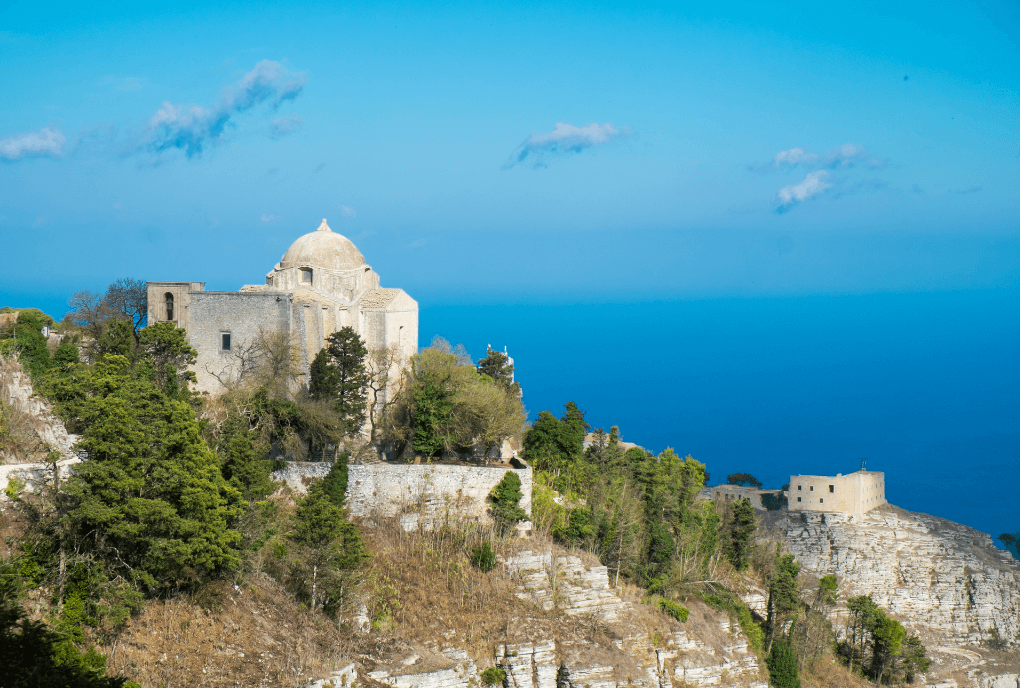
Erice, the city of timeless beauty
Perched on the summit of the mountain of the same name, the 750-meter-high medieval town of Erice towers, enjoying an exceptional panoramic view overlooking the Gulf of Trapani and the Egadi Islands. A fan of cobbled lanes that run between churches, squares and ancient courtyards enticing one to explore the city.
The origins of this medieval village
The town of Erice is an ancient core where stone predominates, appearing throughout the landscape in the town’s architecture. Within the walls of houses, in those of historic buildings, the ancient stone blocks bear unmoving witness to the people who have left us traces among the streets of the country.
According to legend, Erice was founded by fleeing Trojans after the ancient city of Ilium, the Elymians, was destroyed, thus giving rise to the medieval village and city of Segesta(which we have discussed (in this article
). The village was destroyed during the First Punic War because of the support the city of Erice had for the Carthaginians. The battle thus led to the founding of Trapani and the fortification of the walls surrounding Erice, following the conformation of the rock making the town impregnable.
What to see in Erice
The Dome
To best savor the beauty of Erice, it is best to delve into its interior slowly, letting your instincts guide you and getting lost in the cobblestone streets. One of the first places definitely to go is the Duomo, which was erected in 1312 by Frederick III of Aragon before his return to Palermo as a thank you to the city that had hosted him. For the construction of the cathedral, material from the temple of Venus was also used, so much so that on the south side of the church the nine cruciform stone tiles can be seen.
The interior of the church is of rare beauty, covered with white lace in the neo-Gothic style. Later the facade was completed with an elegant rose window and a splendid portico.
At its side stands in all its beauty the Tower of King Frederick, perhaps built over an ancient military watchtower from the Punic period. Here you can climb 110 steps to admire Erice from above, but you know, every little effort is rewarded with a spectacular view!
Venus Castle
The castle stands in the same place where there was a shrine dedicated to the female deity of fertility. In ancient times, it was a place of worship that attracted people from all over the Mediterranean. As the centuries passed, the cult remained the same while the name of the goddess changed. In the time of the Phoenicians the goddess Astarte was worshipped, who became Aphrodite with the Greeks and finally with the Romans took the name Venus. With the arrival of the Catholic Normans, the goddesses were replaced by the Virgin Mary. On the remains of the ancient shrine the Normans built a fortress-castle that still leaves one breathless with its beauty.
Balio Gardens
Continuing the walk through the village streets, one suddenly finds oneself inside a beautiful garden. Here it is possible to perceive the feeling of having crossed the entrance to a parallel world. We are talking about the Viale del Balio, a kind of embrace that makes this place unique, where narrow streets and courtyards are interwoven with the ramps that make up its urban fabric of the medieval village. Railings, cast-iron street lamps, small fountains, and marble stems adorn and blend with the dense undergrowth of shrubs that together with the hedges create an elegant and relaxing environment.
Cyclopean walls
The adjective “cyclopean” really gives an idea of the greatness of the Elymian-Punic walls, which were built by the ancient people of the Elymians to defend Erice between the 7th and 6th centuries B.C., later implemented by the Phoenicians. The city wall starts from Porta Trapani to Porta Spada, consisting of square-shaped megaliths that can reach several tons in weight. On top of some of the boulders you can still see the engraving of some letters of the Phoenician alphabet. Following the path of the Walls, one finds oneself walking inside the magnificent pine forest.
The Church of St. Ursula
It is a small church from 1413, also called the Church of Our Lady of Sorrows, and is located near Porta Spada next to the Cyclopean Walls. Preceded by a courtyard, the building has a simple, linear facade while inside it has a structure that is the sum of two churches. The first, in Catalan Gothic style, from 1413, erected in honor of St. Ursula, and the second, in Renaissance style from 1451, in honor of St. Mary of Jesus. The pavement has majolica parts made in the 1500s by masters from Trapani.
When to visit Erice?
The perched city lends itself to year-round visits because of its timeless beauty, but there are more magical times to go there. For example, during the month of Valentine ‘s Day the village lends itself with all its charm to welcoming love, as one of the most romantic in Sicily. If you would like to know more, we have talked about it here. In addition, during the Christmas season the town is dressed in a bright white atmosphere for the EricèNatale festival, with beautiful nativity scenes, concerts and bagpipers enlivening the evenings. You can find more information here.
How to get to Erice
Located less than 15 kilometers from Trapani, one can reach Erice either by car or by bus, but during the summer months there is a much more unique way of reaching it: it is the cable car that connects Trapani itself with l he summit of Erice. The trip takes about ten minutes and allows you to approach the village while enjoying an exciting view from above.
Giulia Nari





